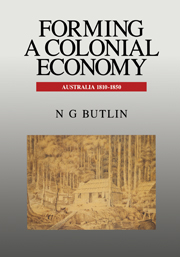Book contents
- Frontmatter
- Contents
- List of Tables
- List of Figures
- Acknowledgements
- Part I Forming an Economy
- Part II The Colonial Peopling of Australia: 1788–1850
- Part III Public Funding of Colonial Development: 1788–1850
- Part IV The Colonial Australian Economy 1810–1840—A Historical, Statistical and Analytical Account
- 11 Summary and Questions
- 12 Towards a Private Market Economy in Australia: 1810–40
- 13 Structural Adjustment and Development: 1810–40
- 14 Growth Performance: 1810–40
- 15 Instability and Economic Fluctuations with Special Reference to the Depression of the 1840s and Recovery
- Bibliography
- Appendixes
- Index
13 - Structural Adjustment and Development: 1810–40
from Part IV - The Colonial Australian Economy 1810–1840—A Historical, Statistical and Analytical Account
Published online by Cambridge University Press: 04 August 2010
- Frontmatter
- Contents
- List of Tables
- List of Figures
- Acknowledgements
- Part I Forming an Economy
- Part II The Colonial Peopling of Australia: 1788–1850
- Part III Public Funding of Colonial Development: 1788–1850
- Part IV The Colonial Australian Economy 1810–1840—A Historical, Statistical and Analytical Account
- 11 Summary and Questions
- 12 Towards a Private Market Economy in Australia: 1810–40
- 13 Structural Adjustment and Development: 1810–40
- 14 Growth Performance: 1810–40
- 15 Instability and Economic Fluctuations with Special Reference to the Depression of the 1840s and Recovery
- Bibliography
- Appendixes
- Index
Summary
Economists and economic historians tend to focus on the question: How well did an economy perform? In other words, how rapidly and consistently did it perform in terms of rates of growth and stability of real product or consumption per head or per unit of factor input. By contrast, in this chapter, we are concerned with the general question of how and why the Australian colonial economies took the shape that they did in terms of the composition of output and the related allocation of resources.
In doing so, it should be appreciated that right up to 1840, the economies had some special peculiarities. This was not simply convictism. Rather, the most important issues arise from the fact that they were very open economies in terms of factor inflows and, for a long time, relatively closed economies in terms of goods flows. Progressively, they became more open in all respects as export and import capability developed. But even by 1840, they were still very isolated despite improving ocean transport links. There is no very simple application of the theory of international trade to be made even though international trade became increasingly relevant. While export potential is important, so too is the response to four basic domestic conditions — the character of natural resource endowment that encouraged specialised natural resource development rather than self-sufficient activity, the demand for a wide range of goods in conditions of isolation, the presence of British skills and relatively high standards of per capita expenditures thanks to external public and private capital.
- Type
- Chapter
- Information
- Forming a Colonial EconomyAustralia 1810–1850, pp. 137 - 196Publisher: Cambridge University PressPrint publication year: 1994

